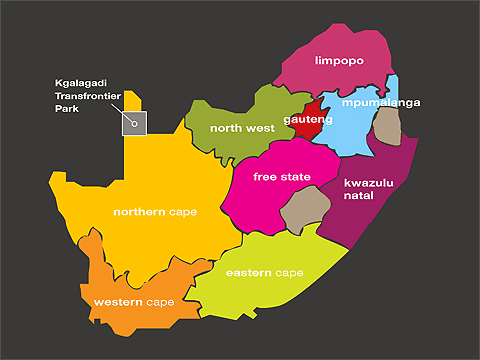Kgalagadi Transfrontier Park in Southern Africa
Kgalagadi Transfrontier Park

Where miles upon miles of rolling rust-red sand dunes and scrub fade into infinity and herds of Gemsbok, Springbok, Eland and Blue Wildebeest, that's where you'll wander onto the Kgalgadi Transfrontier Park. If your heart belongs to the ambience of untamed Africa, this hauntingly beautiful region will be the ultimate answer to your hearts desire.
The Kgalagadi Transfrontier Park was proclaimed in 1931 to protect migratory game, mainly the Gemsbok. This 3,6 million hectares park is one of a few conservation areas of this magnitude left in the world.
The Kgalagadi Transfrontier Park is a creates the canvas for excellent photography opportunities. With its endless red sand dunes, distributed vegetation and the dry riverbeds of the Nossob and Auob, it's the perfect parading ground for antelope and predator. An absolutehaven for bird lovers especially birds of prey.
The waterless Kalahari region receives an annual rainfall of 200 mm, mainly between January and April. Day temperatures may exceed 40°C during the summer time. Winter days are sunny with night temperatures often below zero. Visitors should anticipate extreme heat during the day and extreme cold during winter nights.
Accommodation
Kgalagadi has six different camps of varying size, facilities and cost. Three traditional rest camps, with basic shopping facility and fuel and three wilderness camps, with no fences, invite the Kalahari and the tranquillity of Africa right into your room.
Traditional Rest Camps are:
• Twee Rivieren
• Mata Mata
• Nossob
Wilderness Camps are:
• Bitterpan
• Grootkolk
• Kalahari Tent Camp
Wildlife
The sparse vegetation and concentration of animals in the dry riverbeds of the Auob and Nossob Rivers, Kgalagadi offers superior mammal viewing opportunities. Renowned for predator watching and for seasonal movement of large herbivores such as blue wildebeest, springbok, eland and red hartebeest.
Two of the park's more prominent species are the ground Squirrel and Suricate (Meerkat). Honey Badger (Ratel), Pangolin (Scaly Anteater) and Bat-eared Fox are some of the park specials to search for.
But predators still remain the parks biggest attractions. Keep your eyes open for cheetah, leopard, brown and spotted hyena and the definitive black-maned lion.
Raptors to be spotted are the Tawny and Blackbreasted Snake Eagle, Bateleur, Whitebacked and Lappetfaced Vulture, as well as smaller species such as Pale Chanting Goshawk, Gabar Goshawk, Pygmy Falcon and Greater Kestrel. Ranked as one of the best places in South Africa to view raptors, the Nossob Riverbed is covered with raptors, particularly during the summer months when large numbers of migratory eagles, kites and falcons move through the park.
Travel Hints
Roads in the park have gravel surfaces and are accessible to cars. A 4x4 vehicle is not required, but pick-up's (bakkies) and 4x4's make travelling easier.
How to get there
The entrance at Twee Rivieren Gate is situated approximately 260 km north from Upington.
From Johannesburg - either via Upington (60 km gravel) or via Kuruman, Hotazel and Vanzylsrus (±340 km gravel).
Daily flights to Upington from Johannesburg and Cape Town are available.
Entrance to Botswana
Tourists wanting to visit the Botswana side can enter Botswana at the Gemsbok/Bokspits Border post (60km south of Twee Rivieren), at Middelputs, McCarthy's Rest or Makopong Border posts to visit the Mabuasehube section of Gemsbok National Park. Several campsites are available. A 4x4 vehicle is necessary as well as a valid passport. No visa is required.
Entrance to Namibia
The Mata Mata Border has been opened, but only bona fide tourists to the Park can use the access facility between South Africa and Namibia. Tourists are required to stay over for two nights in one or more of the overnight facilities of the Kgalagadi Transfrontier Park.
|